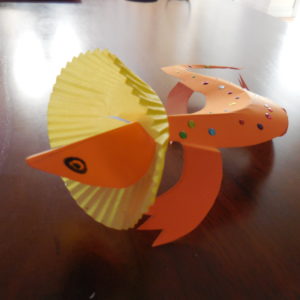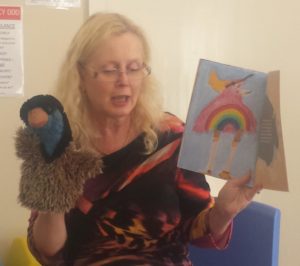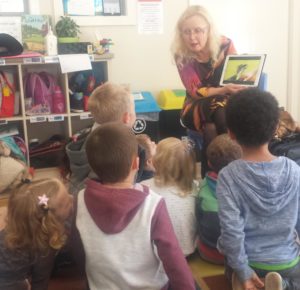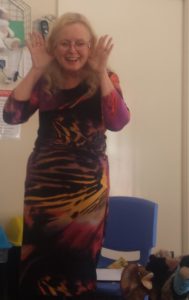One of the best things about being a children’s author is that I get the chance to visit schools and meet lots of young readers. Whether that means reading and entertaining the younger ones with my emu puppet or engaging older readers in writing workshops. Either way, a school visit doesn’t have to be daunting, if well planned it can be exhilarating for the students and the presenter.
Recently, with the launch of my new chapter book, ‘Secrets Hidden Below,’ I have had the opportunity to visit two schools and work with students to encourage them with a few new writing strategies. During Literacy Week in September I had the fantastic opportunity to work with a very talented writing group of year 5 & 6 students from Forrest PS in Canberra, then at the end of October I had the incredible opportunity to work with all year levels from Prep right through to year 8 at the Ela Murray International School in Port Moresby, PNG.
Here are my top 5 take-home points to remember from the experience.
1. Be well prepared. Being asked to present to kids ranging in age from 5 to 14 yrs means varying your workshop to suit their requirements. Even the Preps and year 1-2’s had a slightly different presentation than the other. While the majority of the lesson centred around my picture book, ‘Emma the Eager Emu,’ some fun facts (with pictures) to learn about emus and other Australian birds, I was able to ask higher level questions to the 1’s and 2’s when discussing the themes or lessons learned from the story and able to give them a worksheet that required higher order thinking than their Prep counterparts. It was the same with the writing workshops for the rest of the year levels. With each growing age group I could extend their activities.
2. Be adaptable. No matter how organised you think you are, something will always happen to make you have to change things. In some instances the scheduled time slot for a particular group was longer than I had anticipated, while others had been shortened. Remember, you are a visitor to the school and must fit into their timetable. When my time with the year 3’s and 4’s was extended from 90 min to 2 hours, it meant I could relax, slow the pace, allow more time for students to work on each writing task. It also gave me more time to read exerts from several of my books to use as examples of writing strategies instead of the originally planned one. I initially planned to demonstrate writing devices from ‘Gingerbread Aliens’ only, but given a longer time period I was able to include ‘Secrets Hidden Below’ as well. I loved seeing the students all so engaged and full of questions. On the other hand, because there was a large year 5 - 6 cohort, it was decided to split their original session in two. This meant instead of having 2 hours to work with all of them, I now had an hour each for two groups. To make this work I had to decide which parts of the workshop to skip so that they would get the most benefit out of me being there to help them. Some groups were bigger than I had thought, some were smaller. Again, if you are prepared to adapt, you can make this work. As the year 5-6 groups were so large, the teachers decided to move the lesson into the old library. Not so bad, except in 32 C degree heat with rising humidity and an air con system that seemed to be working overtime, it was a) extremely hot, I could feel the sweat running down my back and my face felt quite flushed no matter how much water I drank, and b) the noise of the air con was so loud I had difficulty hearing some of the students answers. I hope they coped better than I did.
3. Year 7 & 8 aren’t so scary after all. I haven’t taught students of this age in a very long time. In fact, not since I graduated from teachers college over 30 years ago. So the prospect of working with them while exciting, was also a bit daunting. I needn’t have worried, they were a fantastic bunch of kids. I began the session by recognising the fact that my books are not targeted at their age level and presented them as a learning tool for examples of writing devices. The students were all very enthusiastic and eager to participate. We had some great discussions, excellent writing and a whole lot of laughs along the way.
4. Questions and answers can stretch your thinking. Sometimes the responses to questions you ask can be surprising. When demonstrating how to draw a mind map I discovered the enormous vocab students have, no matter their age. Talk about thinking on my feet, I suddenly became very aware of my spelling. To say the year 7 - 8’s tested me, is an understatement. I’m still not sure if I spelt telekinesis correctly. I’m sure they all spotted my mistake. I had some surprising questions asked of me too. Things I had never been asked before that really made me think on my feet. I enjoyed the challenge and hope I answered them all to their satisfaction. I can’t believe I did forget to mention the one thing I do everyday during my spare time, I guess because it has become more of a routine than a spare time activity. That is, walking my dog around the country hills where we live. I walk an average of 5 Km everyday with her. We look for kangaroos, echidnas, wombats, lizards and all sort of birds. You never know what I might find that may spark an idea for a story.
5. Relax and enjoy. It all goes too fast. Relax, breathe and take in every delightful moment. Watching students from all age groups write with such engagement and enthusiasm was awesome. Listening to the excitement in their voices as they shared their work with each other and myself felt wonderful. Observing students madly taking notes from every word I said and slide I presented was surprising yet made me feel quite honoured that they wanted to remember it all. It’s all over all too soon and before you know it, you find yourself alone back in front of your computer screen looking forward to the next school visit. I send my sincerest thank you to everyone at TEMIS, I enjoyed my two days there enormously. A big warm hug to you all.
Now it’s your turn. Have you ever experienced the joy of a writer’s workshop or author visit? Whether from the author’s or student’s point of view, please leave a comment below.
Do you have any questions? I will do my best to answer.







